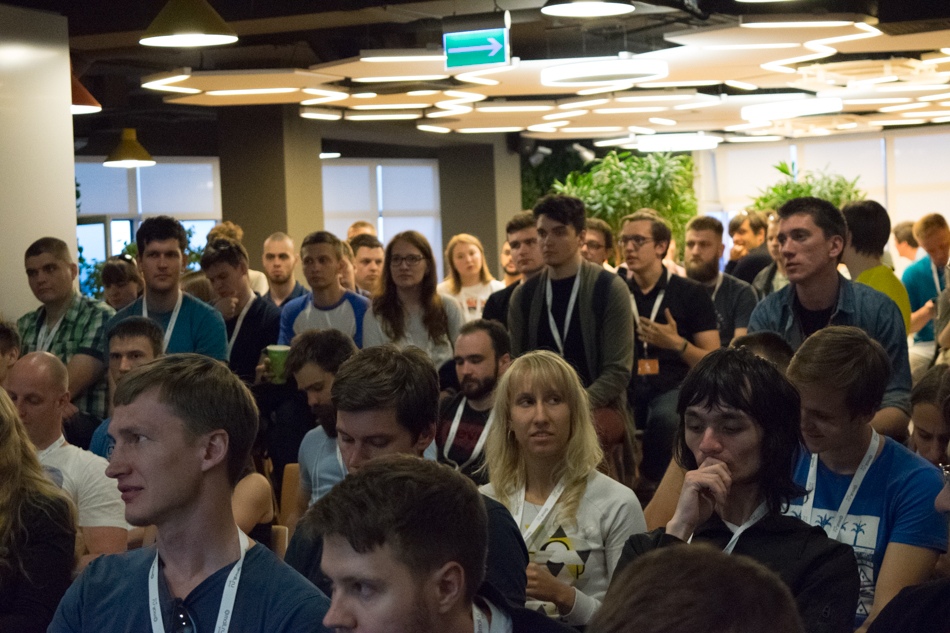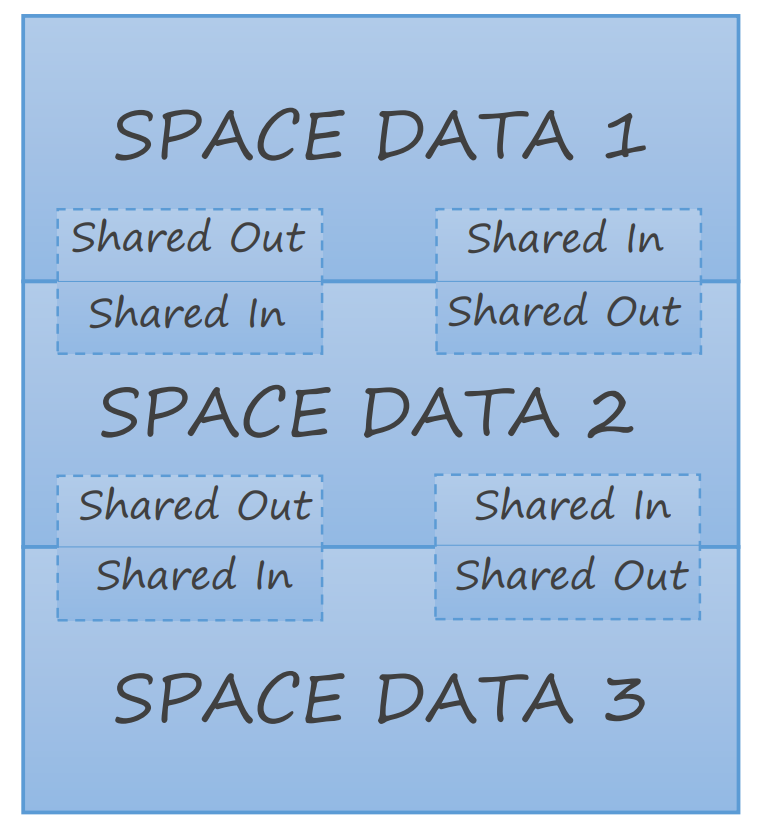A7 Data Server: online data management
Hi, Habr!

We are piloting publications with transcripts of reports sounded on PiterJS.
Since this is the first experience, we will be glad to hear constructive criticism and suggestions for improvement.
Watch videos and slides , and for decoding - welcome under cat.
The report and transcript prepared by Andrei Loginov , CTO at A7 Systems.
Let's start
Fast Big Data Server - server for large fast data. Initially, the A7 DS is designed for Digital Twin , managing roles and data patterns. But this is not all that he can.
What's inside.
Let's get a look:
- Object database
- Temporal (chronological) database
- Javascript virtual machine (to be honest, js-like language)
- Access level system
- Application server
The object database, in addition to typing and inheritance, has several features:
- tree support
- graph support
- mount and link
- Spaces
- Binding support (reactivity)
Space
The most unusual thing here is Space.
Space is an instance of a typical workspace.
Space includes:
- data
- shared-data (shared data for several spaces. For example, weather or currency exchange rate)
- roles (owner, users, groups)
That is, Space is rather isolated from the A7 DS server and other Spaces space.
How to use
Now the question is: how to use it. This is probably the most important question.
Let's create a small mobile application on ECMAScript.
We will need:
- Minimal knowledge of C ++. (possibly within the school curriculum)
- Knowledge of ECMAScript and QML (Qt)
- Android NDK (just to compile it)
In my opinion, the best examples are always associated with money, so we will try to create an online family wallet)).
Create objects in the object database. More precisely, we will create types. It is more convenient to use an editor for describing objects, but we are “not such”, and we will create a description of objects in JSON.
First, create a money object in which we have cash, a credit card, and the total amount:
{ "name": "Money", "fields": [ {"name": "card","fieldtype": "value","datatype": "double", "def": 0}, {"name": "cash","fieldtype": "value","datatype": "double","def": 0}, {"name": "sum","fieldtype": "formula","datatype": "double", "def": "card+credit"} ] } The card and cash fields are simple values (the default is 0), you can write a little shorter:
{"name": "card","value": 0.0}, {"name": "cash","value": 0.0} The sum field is a formula (hello reactivity!) Can also be written a little shorter:
{"name": "sum","formula":"card+credit"} Now we will create a pair of boys and girls.
{ "name": "Pair", "fields": [ {"name": "boyfriend","fieldtype": "value","datatype": "Money", "def": "Money"}, {"name": "girlfriend","fieldtype": "value","datatype": "Money","def": "Money"}, {"name": "sum","fieldtype": "formula","datatype": "double", "def": "boyfriend.sum+girlfriend.sum"} ] } The sum field (hello again reactivity!), Has begun to include references to sub-objects:
{"name": "sum","formula":"boyfriend.sum+girlfriend.sum"} Now, with each change of any digit, we will automatically receive a recalculation of the current balance.
But it's useful for us to add some history.
{"name": "history","fieldtype": "list", "list":{"datatype": "History"}} In a short record
{"name": "history", "list":{"datatype": "History"}} Well, the very object of history. Who, what, and how much has changed.
{ "name": "History", "fields": [ {"name": "who","fieldtype": "value","datatype": "string", "def": “”}, {"name": "which","fieldtype": "value","datatype": "string","def": “”}, {"name": "delta","fieldtype": "value","datatype": "double","def": 0} ] } Add triggers to Pair:
"functions": [{"functiontype": "before", "arguments": [boyfriend.cash], "code": "..." } ] And the trigger code itself:
{ var historyItem= history.add(new History()); historyItem.who=”boyfriend”; historyItem.which=”cash”; history.delta=value-boyfriend.cash; return true; } By analogy, add triggers for boyfriend.card , girlfriend.card , girlfriend.cash .
Since we want to make our application to a large number of pairs, we create a typical SpacePair space, and make it the root element of the Pair .
Add two default usersGirlBoy
Actually everything, a generator of spaces for controlling wallets is ready.
Add some spaces. When adding space, a data area is automatically created (and the data itself with default values). Pre-defined users and groups are also created (for space).
Each space has its users and its own groups.
We start to make the client:
Add to library project
android { debug{ LIBS+= ../A7DS/Libs/android/libA17EDboClientBaseBind.a LIBS+= ../A7DS/Libs/android/libA17ClientLibBind.a } release{ LIBS+= ../A7DS/Libs/android/libA17EDboClientBaseBin.a LIBS+= ../A7DS/Libs/android/libA17ClientLibBin.a } } Fix the main.cpp file a bit
#include <QApplication> #include <QQmlApplicationEngine> #include <QVariant> #include <QQmlEngine> // *.h #include "../A7DS/A17EBase/A17EDboClientBaseBin/a17edboclientbasebin.h" int main(int argc, char *argv[]) { QApplication app(argc, argv); QQmlApplicationEngine engine; // A7DS A17EDboClientBaseBin*client=new A17EDboClientBaseBin(engine,&app); // A7DS client->init(engine); // engine.load(QUrl(QLatin1String(QString("qrc:/main.qml").toLatin1()))); return app.exec(); } On this C ++ part is complete, and we can proceed to QML.
First create a couple of components.
Add a component to display data
MyLabelView.qml
import QtQuick 2.7 import Astra.Dbo 17.0 Item {id: viewItem property alias field: field property string label: " " width: parent.width height: 100 DboField{ id: field } Text { id: labelItem text: viewItem.label anchors.left: parent.left anchors.right: parent.horizontalCenter anchors.top: parent.top anchors.bottom: parent.bottom } Text { id: valueItem text: field.value anchors.right: parent.right anchors.left: parent.horizontalCenter anchors.top: parent.top anchors.bottom: parent.bottom } } MyLabelEdit.qml
import QtQuick 2.7 import Astra.Dbo 17.0 Item {id: viewItem property alias field: field property string label: " " width: parent.width height: 100 DboField{ id: field } Text { id: labelItem text: viewItem.label anchors.left: parent.left anchors.right: parent.horizontalCenter anchors.top: parent.top anchors.bottom: parent.bottom } TextInput { id: valueItem text: field.value anchors.right: parent.right anchors.left: parent.horizontalCenter anchors.top: parent.top anchors.bottom: parent.bottom onEditingFinished:{ field.value=text; } } } Now we will collect the main window
MyLabelEdit.qml
import QtQuick 2.7 import Astra.Dbo 17.0 import QtQuick.Controls 1.5 {id:appWindow visible: true width: 640 height: 480 property var component; property var sprite; ApplicationWindow {id: viewItem property alias field: field property string label: " " property string host: "127.0.0.1" //// A7 DS property int port: 8989 // A7 DS property string isBoy: (dboconnection.login=="Boy") property var myselfMoney: (isBoy)?boyfriend:girlfriend property var myfriendMoney: (!isBoy)?boyfriend:girlfriend /* , */ DboObject{id:boyfriend parentObject: rootData parentFieldName: "boyfriend" } DboObject{id:girlfriend parentObject: rootData parentFieldName: "girlfriend" } DboModel{id:history parentObject: rootData parentFieldName: "history" } /* , , A7 DS */ Column{ z: 10 visible: (! dboconnection.isConnect) anchors.fill: parent TextInput{id:login width: parent.width height: 100 } TextInput{id:password width: parent.width height: 100 } Button{id:btn width: parent.width height: 100 text: ”” onClicked: dboconnection.connectToDbo( login.text, password..text, viewItem.host, viewItem.port); } } SwipeView{ anchors.fill: parent currentIndex: 1 /// Page{ ListView{ model: history delegate: Text{ text: model.who+” ”+model.which+” ”+model.delta } } } /// Page{ Column{ anchors.fill: parent MyLabelEdit{id:myCash; label: “ ” field.name: “cash”; field.parentObject: myselfMoney } MyLabelEdit{id:myCard; label: “ ” field.name: “card”; field.parentObject: myselfMoney } MyLabelView{id:mySum; label: “ ” field.name: “sum”; field.parentObject: myselfMoney } MyLabelView{id:myfriendCash; label: “ ” field.name: “cash”; field.parentObject: myfriendMoney } MyLabelView{id:myfriendCard; label: “ ” field.name: “card”; field.parentObject: myfriendMoney } MyLabelView{id:myfriendSum; label: “ ” field.name: “sum”; field.parentObject: myfriendMoney } MyLabelView{id:mypairSum; label: “ ” field.name: “sum”; field.parentObject: mypairMoney } } } } } Text { id: labelItem text: viewItem.label anchors.left: parent.left anchors.right: parent.horizontalCenter anchors.top: parent.top anchors.bottom: parent.bottom } TextInput { id: valueItem text: field.value anchors.right: parent.right anchors.left: parent.horizontalCenter anchors.top: parent.top anchors.bottom: parent.bottom onEditingFinished:{ field.value=text; } } } Um "But what about the promised Digital Twin, and other nishtyaki?" - Asks the attentive reader.
“Binding is nice, but where are the mounts and graphs?” He adds.
These are fair questions and will be answered in the following articles;).
')
Source: https://habr.com/ru/post/422281/
All Articles